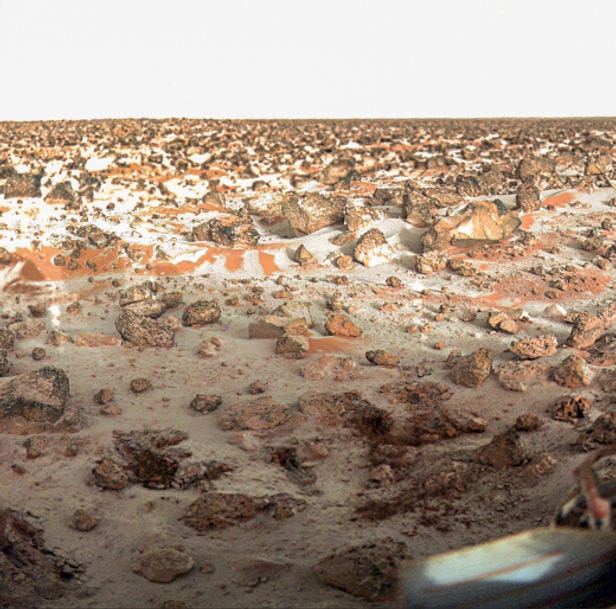It's 1979 & the Viking 2 just landed at the Utopia Planitia landing site
The image shows thin ice. Concise explanation ahead.
Viking Lander 2 took a high-resolution colour photo of the surface of Mars on May 18, 1979, at its Utopia Planitia landing site.
The picture shows a thin coating of water ice on the rocks and soil.
Scientists believe that dust particles in the atmosphere pick up bits of solid water and carbon dioxide, which freeze and adhere to the particles, causing them to sink.
The surface then evaporates the carbon dioxide, leaving behind water and dust. The ice in the picture is extremely thin, perhaps no more than one-thousandth of an inch thick.
Before landing…
Viking 2 launched on September 9, 1975, aboard a Titan IIIE‑Centaur rocket from Cape Canaveral. Remarkably, it reached Mars and began taking images about a year later — an impressive engineering and scientific achievement, considering the timeframe required to travel from Earth to Mars.
Unintentionally, this rocket links to a recent article we posted.
Titan IIIE-Centaur fast facts
Type: Heavy-lift launch vehicle
Stages: 3 main stages (Titan III core + Centaur upper stage)
Role: Designed to send large planetary spacecraft beyond Earth orbit
Nickname: Sometimes called the “Titan III-Centaur”
First use of Centaur on Titan III: Combined the Titan’s raw power with Centaur’s efficient liquid-hydrogen upper stage, perfect for interplanetary missions
Height: About 155 feet (47 meters)
Payload to Mars: Enough to send the massive Viking spacecraft, one of the heaviest planetary probes of its era
Fun fact: Its Centaur stage burned liquid hydrogen and liquid oxygen, making it one of the most advanced high-energy upper stages of the 1970s
On the surface, the lander deploys its scientific instruments.
Let’s see what some of the instruments did
High Gain & Low Gain Antennas — enabled communication with Earth.
UHF Antenna — relayed data to the orbiter.
RTG Power Source — radioisotope generators supplying power.
GCMS Processor — analyzed Martian soil gases (key for life detection).
Seismometer — (highlighted) attempted to detect Marsquakes.
Biology Processor — tested soil for metabolic activity.
Cameras (2) — panoramic Martian surface imaging.
Surface Sampler Boom & Collector Head — scooped soil for experiments.
Meteorology Boom — measured temperature, wind, and pressure.
Terminal Descent Engines — allowed soft landing on Mars.
X-Ray Fluorescence Funnel — analyzed elemental composition of soil.
Magnets — collected magnetic dust for study.
Magnifying Mirror & Magnet Cleaning Brush — supported soil sample inspection.
A great deal of space science has been achieved!
Editor’s Picks






